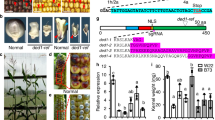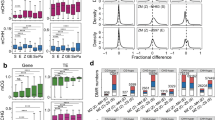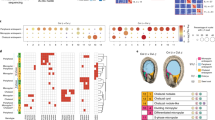Abstract
The regulation of parental genome dosage is of fundamental importance in animals and plants, as exemplified by X-chromosome inactivation and dosage compensation. The ‘triploid block’ is a classic example of dosage regulation in plants that establishes a reproductive barrier between species differing in chromosome number1,2. This barrier acts in the embryo-nourishing endosperm tissue and induces the abortion of hybrid seeds through a yet unknown mechanism3. Here we show that depletion of paternal epigenetically activated small interfering RNAs (easiRNAs) bypasses the triploid block in response to increased paternal ploidy in Arabidopsis thaliana. Paternal loss of the plant-specific RNA polymerase IV suppressed easiRNA formation and rescued triploid seeds by restoring small-RNA-directed DNA methylation at transposable elements (TEs), correlating with reduced expression of paternally expressed imprinted genes (PEGs). Our data suggest that easiRNAs form a quantitative signal for paternal chromosome number and that their balanced dosage is required for post-fertilization genome stability and seed viability.
This is a preview of subscription content, access via your institution
Access options
Access Nature and 54 other Nature Portfolio journals
Get Nature+, our best-value online-access subscription
$29.99 / 30 days
cancel any time
Subscribe to this journal
Receive 12 print issues and online access
$209.00 per year
only $17.42 per issue
Buy this article
- Purchase on Springer Link
- Instant access to full article PDF
Prices may be subject to local taxes which are calculated during checkout




Similar content being viewed by others
References
Johnston, S. A., den Nijs, T. P., Peloquin, S. J. & Hanneman, R. E. Jr. The significance of genic balance to endosperm development in interspecific crosses. Theor. Appl. Genet. 57, 5–9 (1980).
Schatlowski, N. & Köhler, C. Tearing down barriers: understanding the molecular mechanisms of interploidy hybridizations. J. Exp. Bot. 63, 6059–6067 (2012).
Scott, R. J., Spielman, M., Bailey, J. & Dickinson, H. G. Parent-of-origin effects on seed development in Arabidopsis thaliana. Development 125, 3329–3341 (1998).
Rodrigues, J. A. & Zilberman, D. Evolution and function of genomic imprinting in plants. Genes Dev. 29, 2517–2531 (2015).
Kradolfer, D., Wolff, P., Jiang, H., Siretskiy, A. & Köhler, C. An imprinted gene underlies postzygotic reproductive isolation in Arabidopsis thaliana. Dev. Cell 26, 525–535 (2013).
Wolff, P., Jiang, H., Wang, G., Santos-González, J. & Köhler, C. Paternally expressed imprinted genes establish postzygotic hybridization barriers in Arabidopsis thaliana. eLife 4, https://doi.org/10.7554/eLife.1 (2015).
Lu, J., Zhang, C., Baulcombe, D. C. & Chen, Z. J. Maternal siRNAs as regulators of parental genome imbalance and gene expression in endosperm of Arabidopsis seeds. Proc. Natl. Acad. Sci. USA 109, 5529–5534 (2012).
d’Erfurth, I. et al. Turning meiosis into mitosis. PLoS Biol. 7, e1000124 (2009).
Law, J. A. & Jacobsen, S. E. Establishing, maintaining and modifying DNA methylation patterns in plants and animals. Nat. Rev. Genet. 11, 204–220 (2010).
Havecker, E. R. et al. The Arabidopsis RNA-directed DNA methylation argonautes functionally diverge based on their expression and interaction with target loci. Plant Cell 22, 321–334 (2010).
McCue, A. D., Nuthikattu, S., Reeder, S. H. & Slotkin, R. K. Gene expression and stress response mediated by the epigenetic regulation of a transposable element small RNA. PLoS Genet. 8, e1002474 (2012).
Nuthikattu, S. et al. The initiation of epigenetic silencing of active transposable elements is triggered by RDR6 and 21-22 nucleotide small interfering RNAs. Plant Physiol. 162, 116–131 (2013).
Creasey, K. M. et al. miRNAs trigger widespread epigenetically activated siRNAs from transposons in Arabidopsis. Nature 508, 411–415 (2014).
McCue, A. D. et al. ARGONAUTE 6 bridges transposable element mRNA-derived siRNAs to the establishment of DNA methylation. EMBO J. 34, 20–35 (2015).
Martínez, G., Panda, K., Köhler, C. & Slotkin, R. K. Silencing in sperm cells is directed by RNA movement from the surrounding nurse cell. Nat. Plants 2, 16030 (2016).
Slotkin, R. K. et al. Epigenetic reprogramming and small RNA silencing of transposable elements in pollen. Cell 136, 461–472 (2009).
Li, S. et al. Detection of Pol IV/RDR2-dependent transcripts at the genomic scale in Arabidopsis reveals features and regulation of siRNA biogenesis. Genome Res. 25, 235–245 (2015).
Zhai, J. et al. A one precursor one siRNA model for Pol IV-dependent siRNA biogenesis. Cell 163, 445–455 (2015).
Wei, W. et al. A role for small RNAs in DNA double-strand break repair. Cell 149, 101–112 (2012).
Gasciolli, V., Mallory, A. C., Bartel, D. P. & Vaucheret, H. Partially redundant functions of Arabidopsis DICER-like enzymes and a role for DCL4 in producing trans-acting siRNAs. Curr. Biol. 15, 1494–1500 (2005).
Vazquez, F. et al. Endogenous trans-acting siRNAs regulate the accumulation of Arabidopsis mRNAs. Mol. Cell 16, 69–79 (2004).
Peragine, A., Yoshikawa, M., Wu, G., Albrecht, H. L. & Poethig, R. S. SGS3 and SGS2/SDE1/RDR6 are required for juvenile development and the production of trans-acting siRNAs in Arabidopsis. Genes Dev. 18, 2368–2379 (2004).
Schatlowski, N. et al. Hypomethylated pollen bypasses the interploidy hybridization barrier in Arabidopsis. Plant Cell 26, 3556–3568 (2014).
Brennecke, J. et al. An epigenetic role for maternally inherited piRNAs in transposon silencing. Science 322, 1387–1392 (2008).
Martienssen, R. A. Heterochromatin, small RNA and post-fertilization dysgenesis in allopolyploid and interploid hybrids of Arabidopsis. New Phytol. 186, 46–53 (2010).
Kato, A. & Birchler, J. A. Induction of tetraploid derivatives of maize inbred lines by nitrous oxide gas treatment. J. Hered. 97, 39–44 (2006).
Baumberger, N. & Baulcombe, D. C. Arabidopsis ARGONAUTE1 is an RNA Slicer that selectively recruits microRNAs and short interfering RNAs. Proc. Natl. Acad. Sci. USA 102, 11928–11933 (2005).
Lobbes, D., Rallapalli, G., Schmidt, D. D., Martin, C. & Clarke, J. SERRATE: a new player on the plant microRNA scene. EMBO Rep. 7, 1052–1058 (2006).
Zheng, X., Zhu, J., Kapoor, A. & Zhu, J. K. Role of Arabidopsis AGO6 in siRNA accumulation, DNA methylation and transcriptional gene silencing. EMBO J. 26, 1691–1701 (2007).
Allen, E. et al. Evolution of microRNA genes by inverted duplication of target gene sequences in Arabidopsis thaliana. Nat. Genet. 36, 1282–1290 (2004).
Herr, A. J., Jensen, M. B., Dalmay, T. & Baulcombe, D. C. RNA polymerase IV directs silencing of endogenous DNA. Science 308, 118–120 (2005).
Pontier, D. et al. Reinforcement of silencing at transposons and highly repeated sequences requires the concerted action of two distinct RNA polymerases IV in Arabidopsis. Genes Dev. 19, 2030–2040 (2005).
Xie, Z. et al. Genetic and functional diversification of small RNA pathways in plants. PLoS Biol. 2, E104 (2004).
Hehenberger, E., Kradolfer, D. & Köhler, C. Endosperm cellularization defines an important developmental transition for embryo development. Development 139, 2031–2039 (2012).
Moreno-Romero, J., Jiang, H., Santos-González, J. & Köhler, C. Parental epigenetic asymmetry of PRC2-mediated histone modifications in the Arabidopsis endosperm. EMBO J. 35, 1298–1311 (2016).
Schoft, V. K. et al. SYBR Green-activated sorting of Arabidopsis pollen nuclei based on different DNA/RNA content. Plant Reprod. 28, 61–72 (2015).
Goto, K. & Meyerowitz, E. M. Function and regulation of the Arabidopsis floral homeotic gene PISTILLATA. Genes Dev. 8, 1548–1560 (1994).
Harris, C. J., Molnar, A., Müller, S. Y. & Baulcombe, D. C. FDF-PAGE: a powerful technique revealing previously undetected small RNAs sequestered by complementary transcripts. Nucleic Acids Res. 43, 7590–7599 (2015).
Trapnell, C., Pachter, L. and Salzberg, S. L. TopHat: discovering splice junctions with RNA-Seq. Bioinformatics 25, 1105–1111 (2009).
Feng, J. et al. GFOLD: a generalized fold change for ranking differentially expressed genes from RNA-seq data. Bioinformatics 28, 2782–2788 (2012).
Hong, F. et al. RankProd: a bioconductor package for detecting differentially expressed genes in meta-analysis. Bioinformatics 22, 2825–2827 (2006).
Johnson, N. R., Yeoh, J. M., Coruh, C. & Axtell, M. J. Improved placement of multi-mapping small RNAs. G3 (Bethesda) 6, 2103–2111 (2016).
Krueger, F. & Andrews, S. R. Bismark: a flexible aligner and methylation caller for Bisulfite-Seq applications. Bioinformatics 27, 1571–1572 (2011).
Acknowledgements
We thank R. Martienssen and F. Borges for critical comments on the manuscript. We thank H. Jiang for contributing data to Fig. 1. This research was supported by a European Research Council Starting Independent Researcher grant 280496 (to C.K.), a grant from the Swedish Science Foundation 2014-3820 (to C.K.), and a grant from the Knut and Alice Wallenberg Foundation 2012.0087 (to C.K.). G.M. was supported by a Marie Curie IOF Postdoctoral Fellowship (PIOF-GA-2012-330069). Sequencing was performed by the SNP&SEQ Technology Platform, Science for Life Laboratory at Uppsala University, a national infrastructure supported by the Swedish Research Council (VRRFI) and the Knut and Alice Wallenberg Foundation.
Author information
Authors and Affiliations
Contributions
G.M., P.W., R.K.S., and C.K. designed the experiments. G.M., P.W., Z.W., J.M.-R., and C.D.F. performed the experiments and generated the data. G.M., J.S.-G., and L.L.C. carried out the bioinformatic analysis. G.M., P.W., J.S.-G., L.L.C., R.K.S., and C.K. analyzed the data. G.M., P.W., and C.K. wrote the manuscript.
Corresponding author
Ethics declarations
Competing interests
The authors declare no competing financial interests.
Additional information
Publisher’s note: Springer Nature remains neutral with regard to jurisdictional claims in published maps and institutional affiliations.
Integrated supplementary information
Supplementary Figure 1 Small RNA distribution in pollen.
Size distribution of 18-30 small RNA reads in 1n and 2n Col wild-type and nrpd1a pollen.
Supplementary Figure 2 sRNA strand origin for miRNAs and TE-derived siRNAs.
Percentage of plus and minus strand for miRNAs and TE-derived sRNAs in 1n and 2n pollen from Col wt and nrpd1a mutants.
Supplementary Figure 3 RDR6 and DCL4 are responsible for the biogenesis of pollen TE-derived sRNA in the size range of 19-24 nt.
sRNA profiles of TE-derived sRNAs of 1n pollen from Col wild-type, rdr6 and dcl4 rdr6 mutants.
Supplementary Figure 4 Diploid pollen is substantially larger than haploid pollen.
Representative pictures of 1nand 2n Col wild-type and nrpd1a pollen. A minimum of 20 pollen grains per genotype have been analyzed with similar results.
Supplementary Figure 5 Pol IV mutant pollen is able to rescue seed abortion in triploid seeds derived from maternal Ler parents.
Frequency of non-collapsed seeds derived from crosses of wild-type (Ler) maternal parents with osd1 and osd1 nrpd1a. Asterisks mark significant differences (Chi square test, P=2.04E-49 (experiment 1, n=479) and 2.12E-22 (experiment 2, n=303) to the cross Col x osd1.
Supplementary Figure 6 Distribution of TEs among different TE families.
Upper panel shows all TEs, lower panel shows TEs losing CHH methylation in 3x seeds and gaining CHH methylation in 3x nrpd1a seeds. TEs shown in the lower panel are not significantly enriched for a particular TE family (Chi square test). Analysis is based on two biological replicates.
Supplementary Figure 7 Pollen-derived 21/22-nt easiRNAs correlate with loss of CHH methylation in triploid seeds.
(a)Loss of CHH methylation in the endosperm of triploid seeds associates with increasing levels of 21/22-nt easiRNAs in 1n pollen. Plotted are increasing levels of 21/22-nt easiRNAs in 1n pollen sorted by quantiles of 50-bp genome bins against differences of CHH methylation in the endosperm of Ler x osd1 (3x) and Ler x Col (2x) seeds. Differences between categories are significant (P=0, Kolmogorov-Smirnov test). (b) Loss of CHH methylation in the endosperm of triploid seeds associates with gain of Pol IV-dependent 21/22-nt easiRNAs in 1n pollen. Plotted are differences in 21/22-nt easiRNAs in 1n wt and 1n nrpd1a pollen against differences of CHH methylation in the endosperm of 3x and 2x seeds. Differences between categories are significant (P=0, Kolmogorov-Smirnov test). (c) Gain of CHH methylation in the endosperm of triploid nrpd1a seeds associates with gain of Pol IV-dependent 21/22-nt easiRNAs in 1n pollen. Plotted are differences in 21/22-nt easiRNAs in 1n wt and 1n nrpd1a pollen against differences of CHH methylation in the endosperm of 3x nrpd1a and 3x seeds. Differences between categories are significant (P=0, Kolmogorov-Smirnov test). Each box encloses the middle 50% of the distribution, the horizontal line marks the median and the notches the confidence intervals of the median, vertical lines mark the minimum and maximum values that fall within 1.5 times the height of the box. Replicates are specified in the online methods.
Supplementary Figure 8 Expression of NRPD1a in the endosperm of diploid (2x) and triploid (3x) wild-type and nrpd1a seeds.
RPKM values of NRPD1a in the endosperm derived from Ler x Col (2x), Ler x nrpd1a (2x nrpd1a), Ler x osd1 (3x), and Ler x osd1 nrpd1a (3x nrpd1a) seeds. Lines represent mean values. Data are derived from two biological replicates.
Supplementary Figure 9 Small RNA distribution in diploid and triploid seeds.
Size distribution of 18-30 small RNA reads in seeds derived from Ler x Col (2x seeds), Ler x nrpd1a (2x nrpd1a seeds), Ler x osd1 (3x seeds), Ler x osd1 nrpd1a (3x nrpd1a seeds) crosses. R1, R2; replicate 1 and 2, respectively.
Supplementary Figure 10 Increasing gene expression levels in 3x compared to 2x seeds associate with decreasing gene expression levels in 3x nrpd1a seeds compared to 3x seeds.
Boxes show log2-fold expression changes in the endosperm of 3x versus 2x seeds sorted into deciles of log2-fold expression changes in the endosperm of 3x nrpd1a seeds versus 3x seeds. Differences between the top 10% and bottom 10% categories are significant (P=0, Kolmogorov-Smirnov test).
Supplementary Figure 11 Pol IV-dependent sRNAs flank PEG coding regions.
sRNAs mapping to 2kb flanking regions of PEGs (specified in Fig. 4c) and flanking regions of all genes (left and right panels, respectively) in 1n and 2n wild-type and nrpd1a pollen.
Supplementary information
Supplementary Text and Figures
Supplementary Figures 1–11, Supplementary Tables 1–6
Rights and permissions
About this article
Cite this article
Martinez, G., Wolff, P., Wang, Z. et al. Paternal easiRNAs regulate parental genome dosage in Arabidopsis. Nat Genet 50, 193–198 (2018). https://doi.org/10.1038/s41588-017-0033-4
Received:
Accepted:
Published:
Issue Date:
DOI: https://doi.org/10.1038/s41588-017-0033-4
This article is cited by
-
Transcriptome-wide identification and characterization of genes exhibit allele-specific imprinting in maize embryo and endosperm
BMC Plant Biology (2023)
-
Maternal control of triploid seed development by the TRANSPARENT TESTA 8 (TT8) transcription factor in Arabidopsis thaliana
Scientific Reports (2023)
-
Plant and animal small RNA communications between cells and organisms
Nature Reviews Molecular Cell Biology (2022)
-
Dicer promotes genome stability via the bromodomain transcriptional co-activator BRD4
Nature Communications (2022)
-
Transgenerational effect of mutants in the RNA-directed DNA methylation pathway on the triploid block in Arabidopsis
Genome Biology (2021)



